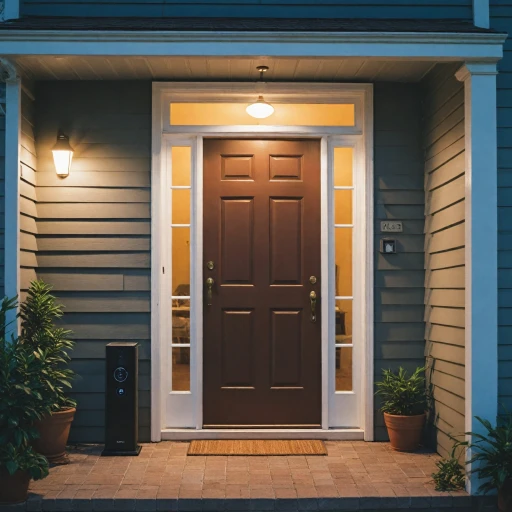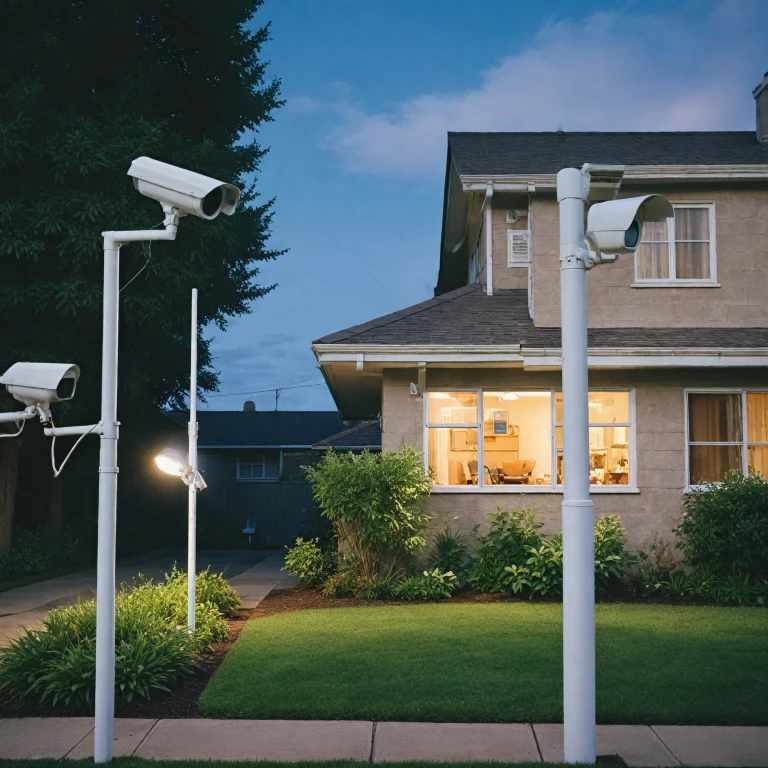Understanding Non-WiFi Security Cameras
Diving Into Security Cameras Without Internet Connection
In a world where staying connected often means relying heavily on WiFi, the concept of security cameras that function without it may seem surprising. Yet, these devices provide a reliable alternative for safeguarding your home, especially in areas with patchy internet or where privacy concerns prevail.
Security cameras without internet, or non-WiFi cameras, operate independently of typical home networks. These cameras can record surveillance footage onto local storage, such as a microSD card, avoiding the reliance on always-on WiFi. This makes them particularly appealing for those needing to monitor remote locations where a WiFi signal cannot reach or in homes seeking to avoid cloud storage costs.
Wireless cameras, like those offered by brands such as Reolink and Lorex, can be powered by rechargeable batteries. This means they can be installed in places without direct access to power, boosting their flexibility and appeal as outdoor security solutions. Combined with features like motion detection and color night vision, these cameras can deliver high-quality surveillance without needing a constant internet connection.
While the allure of self-contained, ‘set it and forget it’ security systems is strong, there are critical challenges and limitations to consider. Non-WiFi cameras may not offer instant alerts or remote viewing capabilities typically available in WiFi-enabled devices. These limitations should be weighed especially if you require real-time monitoring or opt for devices like Amazon's Ring Camera, which capitalizes on internet connectivity to provide robust home security features. For those exploring the best wireless security camera systems, understanding the nuances between these options is crucial.
In conclusion, security cameras without WiFi can provide peace of mind, particularly in areas with limited connectivity. They ensure you have a recording of every significant event even if the internet is out of reach. By examining each camera's specific features, storage options, and power requirements, you can choose the one that best fits your security needs.
Explore more security camera options to find the right fit for your home setup.
Benefits of Using Security Cameras Without WiFi
The Advantages of Non-WiFi Security Cameras
Opting for security cameras that operate without WiFi presents an array of unique benefits for homeowners and businesses alike. For starters, these cameras provide a reliable security solution in areas where WiFi connectivity is poor or non-existent. Let’s delve into some of the specific advantages:
- Consistent operation without internet dependency: Non-WiFi security cameras, such as those from Reolink or Lorex, utilize local storage options. They often save video footage directly onto a microSD card, ensuring that your security system functions even without an internet connection.
- Privacy and security: By not relying on cloud storage or WiFi transfers, cameras without internet connectivity offer enhanced protection against hacking attempts. They typically store footage securely in local storage, reducing the vulnerability of your security data.
- Battery efficiency: Many non-WiFi security cameras are equipped with long-lasting battery power. This is especially beneficial for outdoor installations where wired connections might be cumbersome.
- Freedom of placement: Wireless security cameras can be positioned in locations where WiFi signals struggle to reach, making them ideal for expansive properties or challenges in urban reception.
If you're considering non-WiFi security options, it's beneficial to explore the best wireless cameras without WiFi available on platforms like Amazon. These cameras often boast advanced features such as night vision and motion detection, ensuring comprehensive coverage without reliance on the internet.
Challenges and Limitations
Navigating the Drawbacks and Hurdles of Non-WiFi Security Cameras
When considering a security system that operates without the need for WiFi, certain challenges and limitations can arise. It’s essential to understand these aspects to make an informed decision regarding your outdoor or indoor security setup.
One major obstacle is
limited storage capabilities. Unlike WiFi cameras that can often upload video footage to a cloud storage service, cameras without internet connectivity typically rely on local storage options such as a microSD card or a sim card. This can restrict the amount of footage stored, requiring frequent monitoring and clearing of storage.
Additionally, you may encounter restrictions regarding
remote access and monitoring. While some systems can offer a cellular security option, which provides access without WiFi, this isn't a universal feature. You often lose the flexibility of real-time monitoring found in systems dependent on WiFi internet when using cameras without.
Another consideration is related to
power and battery life. Many of these non-WiFi cameras are wireless and battery-operated, making regular maintenance and battery replacement necessary to ensure they remain functional.
The challenge of
video quality and night vision also comes into play. Although high-quality security cameras like Reolink offer features such as color night vision, not all non-WiFi cameras provide the same level of clarity and detection capabilities.
Despite these challenges, they come with benefits such as enhanced security and privacy, making them the best choice for areas where internet access is unreliable. To determine the optimum security solution for your needs, it’s imperative to weigh these limitations against the benefits, as discussed in our
comprehensive guide to security cameras for your home. By understanding both the advantages and constraints, you can select a system that suits your specific requirements effectively.
Ring Camera: A Closer Look
Evaluating the Features of Ring Cameras
Ring cameras have carved a niche for themselves in the security market, primarily due to their innovative features and user-friendly design. Despite their reliance on WiFi for cloud connectivity, Ring cameras stand out with their robust capabilities that make them an attractive option for home security.
- Video Quality and Night Vision: Ring cameras offer high-definition video quality, ensuring crystal-clear footage. The inclusion of color night vision enhances visibility in low-light conditions, a crucial feature for outdoor and night surveillance.
- Motion Detection and Alerts: With advanced motion detection that triggers alerts, users can receive real-time notifications on their devices. This feature is essential for those who want to stay informed about any unexpected activities around their property.
- Storage Options: While Ring primarily relies on cloud storage, this can be a benefit and a limitation. Cloud storage ensures footage is always accessible from anywhere with an internet connection, but it requires a reliable WiFi signal. Unlike Reolink or Lorex models, which might offer local storage options through a microSD or SIM card, Ring does not operate without internet.
- Smart Integration: Ring cameras are well-equipped to integrate with other smart home devices and systems. This makes them a compelling choice for those looking to build a comprehensive security system tailored to their needs.
Although wireless security cameras offer convenience, cameras like those from Ring necessitate a strong WiFi connection. It’s advisable to compare options like Lorex, known for more robust local storage solutions, or Reolink, offering versatile cameras without internet requirements, to determine the best match for specific security needs. Consider battery options and whether wireless cameras without WiFi might serve as a more fitting choice if internet reliability is a concern.
Installation and Maintenance Tips
Setting Up and Tending to Your Security System
Installing security cameras correctly, especially those that don’t rely on WiFi, is critical in ensuring optimal performance. Although Ring cameras are typically connectable through WiFi, let’s explore how you can navigate the setup process effectively.
- Location Considerations
- Choose the right spot for your Ring camera. Ensure it covers entry points or vulnerable areas in your home or property.
- For outdoor cams, consider weather protection and visibility at night, leveraging their night vision capabilities.
- Power Source and Battery Management
- Review if your security camera requires a steady power supply or if it operates on battery power. For battery-operated cams, assess ease of recharging or changing batteries.
- Wireless security cameras, like those from Reolink or Lorex, often offer flexibility in positioning thanks to battery operation.
- Storage Options
- Evaluate whether you prefer cloud storage or a local solution, like a microSD card. Cameras without internet often rely on local storage, which can limit storage capacity but adds convenience against internet outages.
- Decide if a subscription service for cloud storage suits your needs.
- Connectivity Alternatives
- Ring cameras mainly connect via WiFi internet, but consider alternatives such as cellular security systems if WiFi isn’t available or reliable.
- Video Quality and Features
- Ensure the camera delivers high-quality video footage, with features like motion detection and color night vision.
- Adjust motion sensitivity settings to reduce false alarms while maintaining accurate monitoring.
Regular maintenance involves periodically checking the camera’s hardware and updating its software. By understanding these elements, you can maximize the benefits of your security camera setup. Explore various types of cameras—including wireless or those that work without the internet—to choose what's best for your circumstances.
Choosing the Right Security Camera for Your Needs
Evaluating the Ideal Security Camera for You
When it comes to choosing the right security camera for your needs, focusing on key features and specifications can guide you to make an informed decision. Whether considering cameras that operate without WiFi or those that depend on it, balancing between convenience, security, and functionality is crucial.
- Understanding Connectivity Options: Cameras can be wired, wireless, or cellular-based. Wireless security cameras are popular due to their ease of installation, using WiFi for connectivity. However, if you're often in locations with unreliable wifi internet, a cellular security cam or cameras that work without wifi could be beneficial.
- Storage Considerations: It's essential to think about storage preferences. Some users opt for cloud storage, while others choose local storage options such as using a microsd card. Remember, wireless cameras can have varying storage capacities.
- Video Quality and Night Vision: Look for cams offering high-definition video footage, especially with night vision. Features like color night vision add more depth to the captured footage, crucial for clear identification.
- Power Source: Consider whether a battery-powered cam suits your environment or if a wired option is more reliable. Battery cameras offer flexibility in placement, while wired ones might ensure continuous power supply.
- Additional Features: Features like motion detection and two-way audio can enhance the security system. Motion detection alerts users of any unusual activity, providing an additional layer of security.
- Type of Camera: Determine if you need an outdoor camera with robust weatherproofing or an indoor camera focused on monitoring specific areas inside your home.
By carefully weighing these considerations and aligning them with your personal security needs, you'll be better equipped to find the best security camera solution, whether it's from brands like Reolink, Lorex, or another leading manufacturer. Always ensure that the camera system you choose integrates seamlessly with your existing security setup and supports your long-term security goals.

